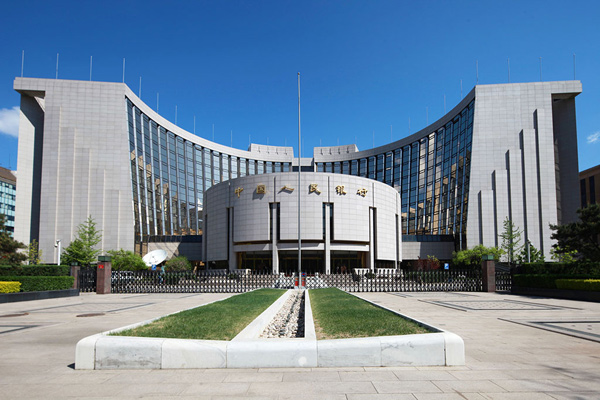

 |
| The People's Bank of China. (File Photo) |
Govt set to focus on supply-side reforms in 2016
As the government has put an emphasis on supply-side reforms such as reducing overcapacity, there should be lower expectations for large-scale monetary easing, which is typically used to boost demand, according to a report released Sunday.
The People's Bank of China (PBC), the central bank, defied market expectations for another interest rate cut last month, so there has been no new monetary easing for two months and the amount of money being put into the open market by the central bank has been shrinking, said the report released by Haitong Securities Co.
The PBC decided not to cut its benchmark interest rates or banks' reserve requirement ratio (RRR), the amount of money banks are required to hold as reserves, even though investors had forecast such moves would come before the New Year.
The PBC's decision not to cut interest rates or the RRR might have something to do with the government's recent focus on tackling oversupply rather than further stimulating demand, the report said.
Supply-side reforms
Weak demand and falling prices of industrial products have caused a supply glut in some sectors, so addressing overcapacity issues was set as a top priority for the country's 2016 economic agenda during the Central Economic Work Conference last month.
The current economic downturn appears on the surface to have been caused by weak demand, but it was actually caused by a shortage of "effective supply," President Xi Jinping said in a speech in October, which was published Thursday by Qiushi, an influential journal under the Communist Party of China.
Speeding up transformation of the country's economic growth pattern and taking decisive measures to resolve overcapacity are the only right ways to improve the quality and effectiveness of economic growth, Xi said.
"If [China] is not focused on structural adjustments and just implements stimulus policies for [the sake of] short-term economic growth, [this] will inevitably affect future growth," Xi noted.
Such comments from top leaders can be taken as signs that stimulus of demand through large-scale monetary easing is unlikely, said the report from Haitong Securities.
Another factor that might have contributed to the PBC's decision not to implement further easing measures recently is concerns about excessive money supply. The official figures have not yet been released, but M2, a broad measure of money supply that covers cash in circulation and all deposits, might have grown 14 percent in 2015, exceeding a target of 12 percent growth, the report also noted.
Less effective
Moreover, monetary policy has not proved that effective recently, following repeated interest rate and RRR cuts by the PBC, said Xu Hongcai, director of the Economic Research Department at the Center for International Economic Exchanges.
The PBC has cut interest rates six times since November 2014, and in 2015 it reduced banks' RRR four times.
It is highly unlikely that the PBC will announce further interest rate cuts this year because rates are already low, Xu told the Global Times on Sunday.
Another consideration is that interest rate cuts could weaken the yuan, especially given "external factors" such as a recent rate hike by the US Federal Reserve, said Xiong Aizong, a research fellow with the Institute of World Economics and Politics at the Chinese Academy of Social Sciences.
But further cuts in the RRR are still necessary given the ongoing downward pressure in the economy, Xiong told the Global Times Sunday.
The Chinese economy is set to face another tough year in 2016, and the manufacturing sector will continue to struggle, according to the report.
The official Purchasing Managers' Index (PMI) for manufacturing in December was at 49.7, showing a contraction in factory activity for a fifth straight month, according to Reuters. A PMI reading above 50 suggests expansion in activity, while one below 50 points to a contraction.
Xiong said monetary easing would continue in 2016, but it's not the only support policy officials will use. He said combining monetary easing with an increase in spending and supply-side reforms could be used as part of the overall strategy to deal with the ongoing downturn.
 Are these the world’s scariest landing strips?
Are these the world’s scariest landing strips? In pics: Left behind children in China
In pics: Left behind children in China Eight modern day engineering marvels of China
Eight modern day engineering marvels of China Chinese beauty with sexiest bottom
Chinese beauty with sexiest bottom Charming female bodybuilders of Chengdu University
Charming female bodybuilders of Chengdu University Polish sports stars strip off for risqué calendar
Polish sports stars strip off for risqué calendar Spectacular aerial photos of the Three Gorges
Spectacular aerial photos of the Three Gorges Contestants of Mrs. Globe pose for photo in Shenzhen
Contestants of Mrs. Globe pose for photo in Shenzhen
 Bikini models attend hot pot banquet in Hefei
Bikini models attend hot pot banquet in Hefei Top 20 hottest women in the world in 2014
Top 20 hottest women in the world in 2014 Top 10 hardest languages to learn
Top 10 hardest languages to learn 10 Chinese female stars with most beautiful faces
10 Chinese female stars with most beautiful faces China’s Top 10 Unique Bridges, Highways and Roads
China’s Top 10 Unique Bridges, Highways and Roads Face of China 2015
Face of China 2015 A hard year 2015’s stories
A hard year 2015’s stories Smartphone makers jockey for dominance of Chinese market
Smartphone makers jockey for dominance of Chinese market Film star's posts stirs debates on Chinese, foreign medical services
Film star's posts stirs debates on Chinese, foreign medical servicesDay|Week